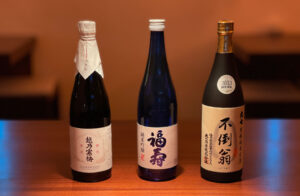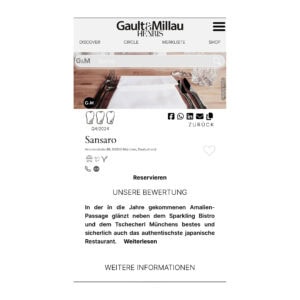Sushi to eat is popular and seems no special art - and yet there are a few tips that will identify you as a connoisseur, make the meal more comfortable and, in addition, increase the pleasure.
After all, Japan is the land of rules - and the more you know, the better you can enjoy sushi like in Japan.
It must be said in advance, however, that this is not the case:
Of course, Japan doesn't just have a thousand rules about how to do things - when it comes to food, the rules also vary according to the style of the region and the quality of the restaurant.
So in one restaurant it may be sacrilege to dip the nigiri sushi (always fish side up!!) in soy sauce, in another it may be ok.
We try to give you the best overview so that you don't act like a clueless barbarian, especially in a Japanese restaurant in Germany.
The most important basic rules:
- Be careful with the chopsticks
- Sushi and sashimi not in soy sauce bath
- Use additional spiciness from wasabi gradually and deliberately
- Ginger is not a salad garnish
- Get involved with the taste & culture of artfully made sushi and enjoy!
How and with what to eat sushi?
Is it okay to eat sushi with your fingers?
In fact, eating sushi with your bare hands is not only allowed, but often the best way to get the perfect taste.
This is quite common in high-end sushi bars in Japan, and you can always see Japanese sushi chefs doing it when they taste sushi. It brings the most immediate taste experience to the delicate little bites. After all, the fingers are often the best instrument for gently taking the graceful sushi and nimbly eating it. After all, the rice ball under the fish should not be pressed like a log, but on the contrary as airy and fluffy as just possible for a rice ball.
Of course, it is clear: the hands must be clean, the environment well-groomed and appropriate for this. And no, this does not mean that the Japanese eat everything else possible with their hands. Japanese culture places great emphasis on purity and cleanliness - and on the use of (clean) chopsticks.
How to eat sushi with chopsticks?
Eating sushi with matching chopsticks is the next best thing to eating with your clean hands; and often the best, depending, What kind of sushi one eats.
Uramaki or some exalted sushi creations may not be at all suitable to be touched directly with the hands.
But the elegant use of chopsticks requires knowledge of some rules and a little background knowledge of Japanese customs.
The chopsticks are placed either next to or - in some restaurants - below the plate, often on a small bench or on the napkin. (By the way, you can also tell by the way the chopsticks are placed. recognize if it is a real Japanese restaurant)
The lower rod is placed in the crook of the thumb and the upper rod is guided movably with the index and middle fingers.
Try not to crush the sushi with the chopsticks, but gently lift them up the sides as parallel to the plate as possible.
Good sushi has a lot of air between the rice grains, which makes the flavor more delicate, but also makes the sushi more fragile.
What not to do with chopsticks
Do not rub the chopsticks together loudly at the beginning. This is a loud audible signal to everyone that the chopsticks you are getting are defective.
And in a good Japanese restaurant you should always get good chopsticks, ideally even made of splinter-free bamboo. So it would be an affront and also not good manners if you let the chopsticks clink loudly together in a better restaurant.
Please avoid pointing the chopsticks at another person.
It is also considered an absolute no-go to leave the chopsticks in the rice, because this immediately reminds the Japanese of a custom from the ancestor cult. Often, the Japanese also place a bowl of rice for their ancestors, who should not starve.
When rice or another diffuse mass (e.g., seaweed salad, spinach, etc.) is taken from a common plate or bowl, one politely turns the chopsticks over and helps oneself with the wide end that is not brought to the mouth.
For the same reason, to avoid contact with your own eating utensils, never pass food with your chopsticks.
If the chopsticks are not needed, place them on the pad next to the plate.
If you put them next to each other on the plate, you signal - just like with cutlery in our country - that you have finished eating and that it is time to clear the table.
So you see, there is a "chopstick sign language".
Sushi please do not bite
Sushi is eaten in one bite. The self-image of any experienced (Japanese) sushi chef is that the bites come in the right size and are perfect for one bite.
If you come across rolls that you want to bite off, you're either in the wrong restaurant - or you've chosen a futomaki whose characteristic is its particular size.
And they can be very tasty, too. In that case, don't put the bitten roll back on the plate, but keep it elegantly in your hand (with the chopsticks, if necessary) until you take the next bite. Just like a small snack.
The same is true for temaki, which of course is also meant to be held in the hand and eaten piece by piece. But of course, the Japanese have all sorts of different rules or behavioral recommendations for all sorts of different varieties and occasions....
Do not eat sushi toppings individually
Nowadays, it actually goes without saying, but just to be on the safe side, don't take the fish off the nigiri sushi and eat it one at a time!
This, even the well-known Jiro says, is the greatest insult imaginable to the sushi master, because, after all, he took a lot of trouble to combine rice and fish perfectly. This is not just a formal thing: with sushi fish and rice belong together historically. With good mildly soured rice, the sushi really tastes good. If you want only fish, order Sashimi.
Slurping, smacking and noises?
As far as noise is concerned, Japan has more or less the same table manners as we do. That is, it is not smacked, slurped or even burped.
We know that our customers would never get the idea, we just say it to be on the safe side. Because there are definitely Asian cultures where loud smacking is quite normal - in Japan and in a Japanese sushi restaurant, please avoid it.
As an aside, yes, the hot Japanese noodle soups ramen or udon are popular to slurp, but not to make noise, but to soak up the hot soup along with some air.
And since miso soup, which is often ordered or served with sushi in Germany, is not supposed to be as hot as the legendary noodle soups, it's better not to slurp it down.
Which sauces & condiments to use with sushi?
Nowadays, sushi can be found all over the world in the most diverse styles and the craziest combinations.
If you want to enjoy real Japanese sushi authentic, it does not hurt to know the context of sushi, Soy sauce, wasabi and ginger to understand.
Japan & the West: different worlds of taste
In Western cuisine, we are used to the fact that the flavor of food comes from seasoning and sauces - many typical German, American, French, Italian dishes are not even conceivable without intensively flavor-forming sauces.
In Japanese cuisine, on the other hand, flavor comes from cutting and the expert, often careful but experienced handling of the carefully selected raw material. A sauce is used only to bring out, to accentuate the natural flavor of an ingredient -. not to give the dish its flavor.
Good sushi tastes by itself, not the sauce
Of course, there are also intensive sauces in Japan such as teriyaki or tonkatsu - but a gourmet should not think of alienating fine sushi with such intensive sauces - it's the pure that counts. Otherwise, one could also eat tofu instead of elaborately filleted fresh fish.
And - to avoid endless discussions and misunderstandings - in Germany the sushi usually comes to the table already with ginger and additional wasabi on the plate, where usually also a soy sauce is already ready.
However, ginger, wasabi and soy sauce must also be used expertly, i.e. in moderation. Because none of these simple additions should mask the taste of the carefully prepared sushi.
Is it allowed to spice up sushi with wasabi?
Japanese cuisine is all about the natural flavors of different ingredients, subtly coordinated.
The sushi master usually already works a little wasabi into the sushi - depending on the type of sushi and ingredients used, a little more or a little less. For some types of sushi, such as uramaki or with cream cheese, no wasabi is added (intentionally).
Now we "non-Japanese" are partly used to somewhat stronger flavors. To make this individual adjustment possible, each guest receives some wasabi and his own small bowl for soy sauce.
Of course, a sushi master will be happy if they attentively listen to his taste tuning and do not drown out everything with spiciness from the start. Stir wasabi into the sauce, but then makes a gradual individual tuning almost impossible. Try to taste the different ingredients as you were put together, to capture the seasoning of the rice.
If possible, practice stirring wasabi into the soy sauce only at Sashimi. And if the sushi is not properly seasoned or tastes terribly boring without extra wasabi, just try another restaurant.
Small pro-tip: we like to try the cucumber roll (kappamaki) to check the quality of a new restaurant.
How much soy sauce with sushi?
In the perfectly seasoned, finely shiny rice, the chef demonstrates much of his skill.
That's why even a connoisseur will never put the rice in Soy sauce drown, but only dip the fish or vegetables a little in the soy sauce.
To marinate sushi rolls in soy sauce for a short time, for example, is unbearable for the Japanese - it only makes the sushi completely salty.
When you eat gunkan, it is recommended to take a ginger leaf, dip it in soy sauce, and use it to gently spread the soy sauce on the topping of the gunkan. So you act in style and avoid disasters in soy 😉
Ginger to neutralize the taste
Pickled ginger (gari) simply belongs for many sushi fans. It serves in masses to "neutralize" the taste buds between the different sushi. Many a time, ginger can also be used to elegantly spread some soy sauce over difficult to eat sushi like gunkan.
However, you should not think of the ginger as some sort of side salad. And certainly never get the idea to simply put the ginger on the sushi as a kind of additional topping.
Health Tip:
Use soy sauce, ginger and wasabi paste sparingly - as the Japanese do. Pay attention to this, which Soy sauce used in a restaurant - high quality organic soy sauce. from a traditional manufacturing process or industrially produced NoName goods?
How to season sashimi
Sashimi is not sushi, but it should still be briefly mentioned here:
If there is no ginger with the sashimi, then everything is ok: Sashimi is not served with pickled ginger, but with finely sliced radish. By the way, from how thinly this radish is cut, you can also tell the qualification of the cooks.
Many people in the West then mix wasabi with soy sauce before dipping sashimi. However, some of the essential flavors of wasabi dissolve in the process.
To enjoy sashimi properly, put a little wasabi on the fish, dip the fish very briefly in the soy sauce in another place, and then enjoy it directly. The fattier the fish, the more wasabi it will tolerate (e.g. tuna, salmon, mackerel). However, wasabi and soy sauce should only ever be a light flavorful addition, never some sort of marinade.
Please request none Teriyaki or chili sauce for sashimi, this only destroys the flavor that the chef has brought out in the raw fish by artfully cutting it. In this way, you also give the Japanese restaurant the feeling that they are trying to achieve the highest quality for you for nothing.
By the way, it is also best to avoid restaurants whose sashimi selection is usually offered in combination with all kinds of intense sauces: this only covers up the fact that the raw material of moderate quality has probably been prepared for some time and the chefs are not very experienced.
The best order to eat sushi
For sushi lovers, there is a very simple order in which sushi is best enjoyed: from light to fattier - translated to the flesh of the fish: from white to red.
This rule has something to do with both the intensity of taste and the feeling of satiety. In many sushi restaurants, the various types of sushi are already arranged on the plate in the correct order from right to left. However, if the plate has a special visual design, simply choose for yourself.
You start with the light, low-fat fish, with white meat or squid, then you can continue about the "silver fish", for example, the mackerel pike, then follows salmon or salmon roe and at the end is consumed fatty fish with red meat.
So you eat from easily digestible to more satiating, which makes sense not only in terms of taste, but also according to modern nutritional findings.
Such a complete sushi epicurean meal can be rounded off with a piece of tamago, the artfully folded Japanese omelet, which often has a subtle sweetness. By the way, tamago is also often used for this in high-end Japanese sushi bars.
From what or what to eat sushi?
Popular in Japan are of course the "sushi geta", the wooden boards in the shape of the classic Japanese wooden shoes. Such geta are a funny thing - but you should make sure that they are in good condition and the wood is not already scuffed at the edges and the geta is used up. This also says something about the restaurant.
Ditto for the dishes. Whether you eat sushi on wood, on dishes, or maybe even straight from the counter in a classic sushi counter bar (omakase style) where the chef puts the sushi right in front of you: Everything is actually ok as long as it's clean, hygienic, neat - and not just white.
Because while white dishes are considered the standard in Western, French-inspired gastronomy, pure white dishes throughout are actually unsuitable for Japanese cuisine and especially sushi. The great Japanese writer Junichirō Tanizaki sums it up nicely when he describes:
It is often said that Japanese cuisine is not for eating, but for looking at.
Whoever sees that freshly cooked, pure white rice, how it lets warm steam rise from under the quickly lifted lid, how it lies piled up in the black vessel and how every single grain shines like a pearl, will, if he is a Japanese, really feel the awe of the rice.
Probably in all countries, the coloring of the food should be kept to harmonize with the color of the dinnerware and also the walls of the room. In any case, it is certain that if you eat Japanese food in a bright place on white dishes, your appetite would decrease by half.
"In Praise of Shadow - Outline of a Japanese Aesthetic" by Junichirō Tanizaki (1886 -1965)
The tableware used thus also gives you information about the restaurant you are in.
What drinks with sushi?
A variety of drinks can go with sushi - and they don't all have to be Japanese. Here we give a few general recommendations about typical drinks to go with Japanese sushi.
Sushi & Beer
Some people don't even know it: Japan is a great beer nation, quite a bit comparable to Germany. There are numerous seasonal beer varieties in Japan and beer as a drink is widespread. It is also often served with sushi in sushi bars of all price ranges.
Sushi & Sake
High-quality premium sake is, of course, among the best accompaniments to fine sushi and sashimi that you can choose.
Since sake is made from rice, it goes without saying that it goes perfectly with sushi, which is also made with rice. And interestingly the invention of rice vinegarwhich gives sushi its delicate flavor, also directly linked to the production of sake.
It is also scientifically proven that sake helps to round out the umami taste of the fish and to underline.
The taste and characteristics of sushi vary depending on the ingredients, and so do the sakes that are recommended to accompany it.
In general, however, it is best to drink a light, dry sake, either slightly chilled or at room temperature, so as not to spoil the delicate flavors of the sushi. A sweet sake should be recommended with sushi with a sweet sauce, such as unagi (eel).
Sushi & Wine
Wine is getting more and more attention in Japan these days - there are even wine varieties that are grown in Japan. Because of its acidity, German Riesling in particular is a good partner for sushi. It breaks down the proteins from the white fish quite well.
Red wine, especially if heavily tannic, is not recommended to accompany sushi.
Sushi & green tea
Green tea is the drink of choice when dining at the most expensive sushi restaurants in Japan. There, you don't get sake, wine or champagne with your sushi - but only a cup of green tea at the end, if you wish. Of course, nothing should distract from the pure pleasure of eating.
And the green tea, which of course also has a great proximity to the high form of Japanese cuisine, the kaiseki, through the tea ceremony, is the most meditative drink for this. And quite honestly: in a high-end sushi restaurant you don't even have the time to empty a bottle of wine - because there you may gratefully get up and leave a few minutes after the meal.
Eating sushi with the right attitude
Good sushi is a craft, really good sushi is an art form. Most people don't realize how much preparation and how much effort is required to consistently prepare really good sushi from quality ingredients.
Even if little money is spent on food in Germany and there seems to be little awareness of quality - it doesn't hurt to adapt a little to the cultural customs from Japan.
Omotenashi
Omotenashi is the well-known Japanese form of hospitality.
A Japanese host, especially also a restaurant or hotel owner, will always try to take care and look after the guest completely with a wide open heart and a lot of attention. Omotenashi also means trying to pay attention to every detail so that the guest has a complete, delightful experience.
For this to succeed, Omotenashi is also a relationship based on mutual respect: the guest respects and appreciates the efforts of the host.
Therefore, especially in genuine Japanese restaurants with Japanese staff or Japanese philosophy, the following applies: do not enter like a German king or emperor, but with a certain respect and Japanese caution, then the staff will be heartily at your service and try to make you feel completely at home.
Please wait to be seated
If the staff is dedicated to the cause with Japanese commitment, they will always try to give you the best possible place and respond to your needs!
Make it easy for service by not rushing right to the seat you think is best when you visit.
First, arrive briefly, make eye contact with the staff, and look forward to being taken care of.
Come with the understanding that a good sushi restaurant requires a lot of coordination between the sushi bar/kitchen and the service - there are different rules here than in a Bavarian restaurant or even in a good Italian restaurant - the ordering process and therefore all the procedures between the sushi bar, the hot kitchen and the guest room are much more complex.

Avoid strong perfumes in the sushi restaurant
Of course, mood, ambience, room size is different in every sushi restaurant.
In Japan, however, people think like this: Sushi wants to be perceived with all senses, the aroma is absorbed by nose, mouth, palate and tongue.
If this perception for your neighboring table or table mate is covered by a strong perfume tail, then that is a bit inconsiderate.
So go to high-end restaurants if then only with very little and very unobtrusive perfume.
In Japan there is even a own word for "odor nuisance" in connection with perfumes (香害, kōgai).
So: stay discreet, with perfume, the volume, your appearance. In short: try to behave a little bit Japanese 😉.
More tips
You can find a few more hints in a Article from us about a typical visit to a Japanese (sushi) restaurant.
And if you are still missing some information here, or if we have not explained it in a way that is understandable from your point of view, feel free to write to us!





